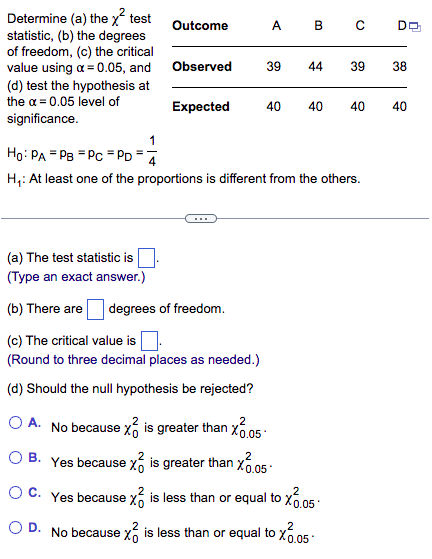Home /
Expert Answers /
Statistics and Probability /
determine-a-the-chi-2-test-statistic-b-the-degrees-of-freedom-c-the-critical-valu-pa584
(Solved): Determine (a) the \( \chi^{2} \) test statistic, (b) the degrees of freedom, (c) the critical valu ...
Determine (a) the \( \chi^{2} \) test statistic, (b) the degrees of freedom, (c) the critical value using \( \alpha=0.05 \), and (d) test the hypothesis at the \( \alpha=0.05 \) level of significance. \( \mathrm{H}_{0}: \mathrm{p}_{\mathrm{A}}=\mathrm{p}_{\mathrm{B}}=\mathrm{p}_{\mathrm{C}}=\mathrm{p}_{\mathrm{D}}=\frac{1}{4} \) \( \mathrm{H}_{1} \) : At least one of the proportions is different from the others. (a) The test statistic is (Type an exact answer.) (b) There are degrees of freedom. (c) The critical value is (Round to three decimal places as needed.) (d) Should the null hypothesis be rejected? A. No because \( \chi_{0}^{2} \) is greater than \( \chi_{0.05}^{2} \). B. Yes because \( \chi_{0}^{2} \) is greater than \( \chi_{0.05}^{2} \). c. Yes because \( \chi_{0}^{2} \) is less than or equal to \( \chi_{0.05}^{2} \). D. No because \( \chi_{0}^{2} \) is less than or equal to \( \chi_{0.05^{2}}^{2} \)
Expert Answer
The StatCrunch path for performing chi square goodness of fit test is: Stat --> Goodness-of-fit --> Chi-square Test
